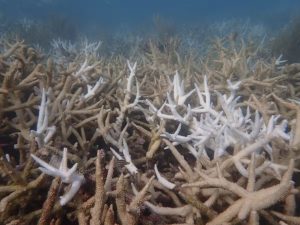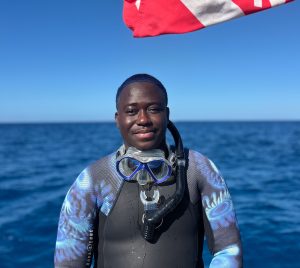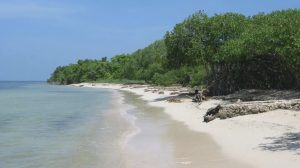by Stanton Charlton, Communications Specialist at PIMS
For several months now, the world has become familiar with the increasing ferocity of COVID-19. Stony Coral Tissue Loss Disease (SCTLD) may be equally threatening, if not moreso, to Caribbean coral reefs. After confirming its spread to Grand Bahama in March, we can now also confirm that this threat has made its way to New Providence.
Montastrea cavernosa (large-cup star coral)Infected with SCTLD at all six sites© Hayley-Jo Carr (PIMS & Reef Rescue Network)
SCTLD was first sighted off Miami’s coast in 2014 and provoked increasing discussion of how to contain its spread. Over the past 2-3 years, SCTLD became a more significant threat, and efforts to contain it were unsuccessful. The disease infected coral reefs in Mexico, Belize, Puerto Rico, the Dominican Republic, the Turks and Caicos Islands, the U.S. Virgin Islands, Saint Martin and Saint Eustacius.By the time SCTLD was confirmed in Grand Bahama in March, the Perry Institute for Marine Science scheduled a webinar explaining its significance to the public. Following the April 13th webinar, we implemented a mechanism to report SCTLD and encouraged participants to share potential sightings.On June 4th, 2020, we were able to investigate SCTLD reports that were shared with us. Six sites were surveyed between Columbus Cove and Lighthouse Boulders.The presence of SCTLD was confirmed at all six sites.
Pseudodiploria strigosa (symmetrical brain coral)Infected with SCTLD at all six sites© Hayley-Jo Carr (PIMS & Reef Rescue Network)
After counting 1,257 corals, we found that 37% of them had become infected with SCTLD. Based on initial rapid assessments, 11 species of coral have SCTLD in New Providence. Of the 11 species, the following were most commonly infected:
- Montastrea cavernosa (large-cup star coral)
- Pseudodiploria strigosa (symmetrical brain coral)
- Dilporia labryinthiformis (grooved brain coral)
- Pseudodilporia clivosa (knobby brain coral)
- Orbicella annualaris (lobed star coral)
Dipoloria labyrnthiformis (grooved brain coral)Infected with SCTLD at: Traveler’s, Sandyport, Baha Mar and Lighthouse Boulders© Hayley-Jo Carr (PIMS & Reef Rescue Network)
It is worth noting that infection rates did vary across the six sites, but Sandyport and sites to the east had the highest infection rates.The discovery of SCTLD on New Providence could have serious implications for the coral reef population for our entire archipelago.According to Dr. Krista Sherman, PIMS Senior Scientist, “Nassau, is the hub for the country and if we are unable to effectively contain SCTLD here, it is likely to spread to other islands. Given the significance of reefs to the environment and our economy, this would be devastating.”The proximity of SCTLD to the Nassau Harbour presents an urgent need for action to protect healthy reefs from the disease. Based on the data we have now, we believe vessels commuting between Grand Bahama, New Providence and Florida may have expedited the spread of SCTLD.This discovery presents an ideal opportunity to aggressively contain the disease. If we miss this opportunity, the consequences may be severe for Bahamian reefs. Like COVID-19, SCTLD spreads quickly. However, SCTLD’s deadliness to coral reefs is even more alarming.“Not since diving after Hurricane Matthew back in 2016 have I seen such devastation on our coral reefs around Nassau. This disease is moving so fast and every coral infected appears to not survive at all, with 100% mortality of the colony occurring,” said Hayley-Jo Carr, Training Director & Coordinator at PIMS’s Reef Rescue Network. “On the reefs infected, you can literally just leapfrog from one infected coral colony to the next. It’s an extremely upsetting situation and one that is going to have a disastrous effect on our already suffering coral reefs if actions are not taken swiftly to combat its spread.”Given the significance of this threat, we are leading research efforts and working with local partners, such as Bahamas National Trust, to effectively respond.
New Providence SCTLD rapid assessment team from left to right – Hayley-Jo Carr and Dr. Krista Sherman (Perry Institute for Marine Science), Shelley-Cant Woodside and Pachancia Knowles (Bahamas National Trust)
“We are working with partners to develop and implement strategies to mitigate the impacts of SCTLD to reefs and will be integrating this work into our coral reef research, monitoring and restoration program moving forward,” Dr. Sherman said.So, what can you to stop the spread of SCTLD and protect our reefs?
- Limit how the disease is transported by humans by disinfecting bilge water and dive/snorkel gear between dive sites using a mild bleach solution of hydrogen peroxide-based disinfectant.
- Commercial ships must properly exchange ballast water by to prevent spreading the disease.
- Report new locations where corals are showing signs of the disease. If we catch it early on a reef, we can prevent its spread to other corals on the reef.
Click here to download our complete report on SCTLD in New Providence.

Build a Coral Reef for the Holidays | PIMS x Partanna
PIMS is partnering with Partanna to build a 100m² carbon-negative reef. Rick Fox is matching donations up to $25k. Help us build a sanctuary for the future.

“Seafood Nation” Documentary Premiere Explores the Heart of Bahamian Culture and the Future of Fisheries
NASSAU, The Bahamas | December 5, 2025 – From the bustling stalls of Potter’s Cay to family kitchen tables across the archipelago, seafood is far more than just sustenance in

PIMS and Disney Conservation Fund Partner to Train 19 Government Divers
PIMS dive training in Nassau strengthened national coral restoration capacity across government agencies. Bahamas Dive Training Builds National Coral Restoration Capacity Last fall, between the months of September and October,

Florida’s Coral Reef Crossed a Line: What Functional Extinction Really Means for Elkhorn and Staghorn Corals
Reefs didn’t just bleach. They functionally vanished in one summer. A new Science study co-authored by researchers from the Perry Institute for Marine Science (PIMS) has found that Florida’s two

Q&A: Understanding the IDC Course at PIMS with Duran Mitchell
A former aquarist turned coral conservationist, Duran is passionate about understanding how all marine life connects. PIMS & IDC: Empowering New Dive Instructors for Marine Conservation PIMS & IDC: Empowering

Forbes Shines a Spotlight on Coral Reef Restoration in the Caribbean
When Forbes highlights coral reef restoration, it signals something powerful: the world is paying attention to the urgent fight to protect reefs. And solutions are within reach. Recently, Forbes featured Dr. Valeria


